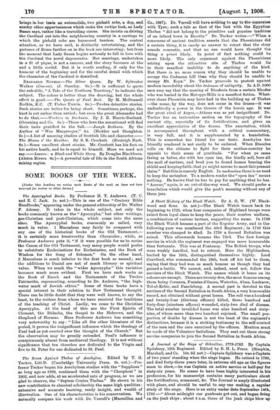A Short History of the Black Watch. By A. G.
W. (W. Black- wood and Sons. Ss. net.)—The Black Watch traces back its beginning to 1725, when four companies of Highland troops were raised from loyal clans to keep the peace, their sombre uniform, a combination of various tartans, suggesting the name. In 1739 the Black Watch became a part of the Regular Army, and in the following year was numbered the 43rd Regiment ; in 1749 this number was changed to 42nd. In 1758 a Second Battalion was raised. This afterwards became the 73rd. The first foreign service in which the regiment was engaged was more honourable than fortunate. This was at Fontenoy. The British troops, who were weakly handled, had to retreat. Here the Highlanders, backed by the 19th, distinguished themselves highly. Lord Crawford, who commanded the 19th, took off his hat to them, saying that they had won as much honour as though they had gained a battle. We cannot, and, indeed, need not, follow the services of the Black Watch. The names which it bears on its colours are enough. There are twenty-five, the most famous among them being Corunna, Fuentes d'Onoro, Waterloo, Alma, Lucknow, Tel-el-Kebir, and Paardeberg. A second part is devoted to the services of the Second Battalion in South Africa, a very honourable record, not obtained without great losses. The roll was a hundred and twenty-four (thirteen officers) killed, three hundred and forty-four (nineteen officers) wounded, sixty-two died of disease. The total number invalided home. was nine hundred and sixty- nine, of whom more than two hundred rejoined. The small pro- portion of deaths by disease is not the least of the regiment's distinctions, because it is a striking testimony to the self-control of the men and the care exercised by the officers. Mention must be made of the Volunteer battalions. They sent out three strong service companies to join the Second Battalion in South Africa.


































 Previous page
Previous page